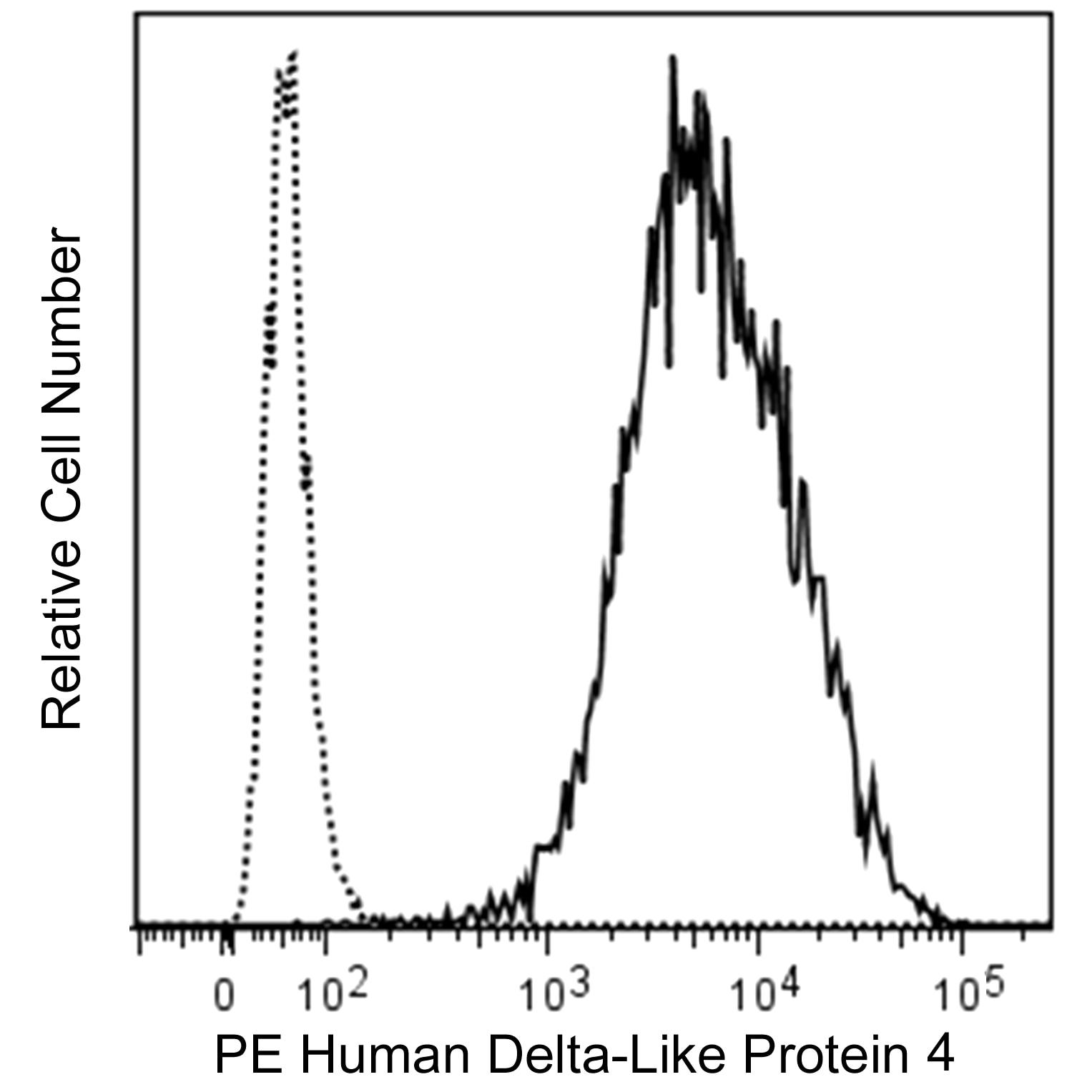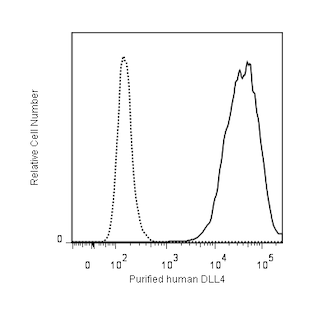Old Browser
This page has been recently translated and is available in French now.
Looks like you're visiting us from {countryName}.
Would you like to stay on the current country site or be switched to your country?


.png)

Flow cytometric analysis of human Delta-Like Protein 4 on DLL4-transfected CHO cells. Human DLL4-transfected Chinese Hamster Ovary (CHO) cells were stained with either PE Mouse IgG1, κ Isotype Control (Cat. No. 554680; dotted line histogram) or PE Mouse Anti-Human Delta-Like Protein 4 antibody (Cat. No. 564412; solid line histogram). Fluorescence histograms showing the expression of Delta-Like Protein 4 (or Ig Isotype Control staining) were generated for gated events with the forward and side light-scatter characteristics of viable CHO cells. Flow cytometric analysis was performed using a BD FACSCanto™ II Flow Cytometer System.
.png)

BD Pharmingen™ PE Mouse Anti-Human Delta-Like Protein 4
.png)
Regulatory Status Legend
Any use of products other than the permitted use without the express written authorization of Becton, Dickinson and Company is strictly prohibited.
Preparation And Storage
Product Notices
- Please refer to www.bdbiosciences.com/us/s/resources for technical protocols.
- Since applications vary, each investigator should titrate the reagent to obtain optimal results.
- An isotype control should be used at the same concentration as the antibody of interest.
- Caution: Sodium azide yields highly toxic hydrazoic acid under acidic conditions. Dilute azide compounds in running water before discarding to avoid accumulation of potentially explosive deposits in plumbing.
- For fluorochrome spectra and suitable instrument settings, please refer to our Multicolor Flow Cytometry web page at www.bdbiosciences.com/colors.
Companion Products




The MHD4-46 monoclonal antibody specifically binds to Delta-Like Protein 4 which is also known as Delta4, DLL4, and DL4. Delta-Like Protein 4 is a type 1 transmembrane glycoprotein which belongs to the Delta/Serrate/Jagged Family of Notch receptor ligands. The Notch family of transmembrane receptors and their ligands play key roles in various developmental and postnatal processes by controlling cell-fate decisions. Delta-Like Protein 4 is expressed by vascular endothelial cells within certain normal tissues and tumors. It signals through Notch1 and Notch 4 Receptors and plays a critical role in vascular development and homeostasis. Delta-Like Protein 4 expression is upregulated in response to vascular endothelial growth factor (VEGF) and regulates endothelial cell proliferation during vascular sprouting. Delta-Like Protein 4 is also expressed by activated human monocytes and dendritic cells that have been stimulated with proinflammatory activators such as lipopolysaccharide. Recent evidence suggests that Delta-Like Protein 4 may contribute to the T cell potential of CD34+ cells and to the growth of various tumors, and promote tumor cell infiltration.
During product development, the specificity of the purified MHD4-46 antibody (Cat. No. 564589) was confirmed by immunohistochemical staining of acetone-fixed frozen sections of human placenta. Vascular endothelial cells were specifically stained (data not shown).

Development References (10)
-
Artavanis-Tsakonas S, Rand MD, Lake RJ. Notch signaling: cell fate control and signal integration in development.. Science. 1999; 284(5415):770-6. (Biology). View Reference
-
Fung E, Tang SM, Canner JP, et al. Delta-like 4 induces notch signaling in macrophages: implications for inflammation. Circulation. 207; 115(23):2948-2956. (Biology). View Reference
-
Gurney A, Hoey T. Anti-DLL4, a cancer therapeutic with multiple mechanisms of action. Vasc Cell. 2011; 3(18):21. (Biology). View Reference
-
Herr F, Schreiner I, Baal N, Pfarrer C, Zygmunt M. Expression patterns of Notch receptors and their ligands Jagged and Delta in human placenta. Placenta. 2011; 32(8):554-563. (Biology). View Reference
-
Lefort N, Benne C, Lelievre JD, et al. Short exposure to Notch ligand Delta-4 is sufficient to induce T-cell differentiation program and to increase the T cell potential of primary human CD34+ cells. Exp Hematol. 2006; 34(12):1720-1729. (Biology). View Reference
-
Mailhos C, Modlich U, Lewis J, Harris A, Bicknell R, Ish-Horowicz D. Delta4, an endothelial specific notch ligand expressed at sites of physiological and tumor angiogenesis. Differentiation. 2001; 69(2-3):135-144. (Biology). View Reference
-
Sekine C, Koyanagi A, Koyama N, Hozumi K, Chiba S, Yagita H. Differential regulation of osteoclastogenesis by Notch2/Delta-like 1 and Notch1/Jagged1 axes. Arthritis Res Ther. 2012; 14(2):R45-R58. (Immunogen: Flow cytometry). View Reference
-
Shutter JR, Scully S, Fan W, et al. Dll4, a novel Notch ligand expressed in arterial endothelium. Genes Dev. 2000; 14:1313-1318. (Biology). View Reference
-
Shutter JR, Scully S, Fan W, et al. Molecular cloning of delta-4, a new mouse and human Notch ligand. J Biochem (Tokyo). 2001; 129(1):27-34. (Biology). View Reference
-
Wakui M, Nakano K, Matsushita S. Notch ligand mRNA levels of human APCs predict Th1/Th2-promoting activities. Biochem Biophys Res Commun. 2007; 358(2):596-601. (Biology). View Reference
Please refer to Support Documents for Quality Certificates
Global - Refer to manufacturer's instructions for use and related User Manuals and Technical data sheets before using this products as described
Comparisons, where applicable, are made against older BD Technology, manual methods or are general performance claims. Comparisons are not made against non-BD technologies, unless otherwise noted.
For Research Use Only. Not for use in diagnostic or therapeutic procedures.
Report a Site Issue
This form is intended to help us improve our website experience. For other support, please visit our Contact Us page.